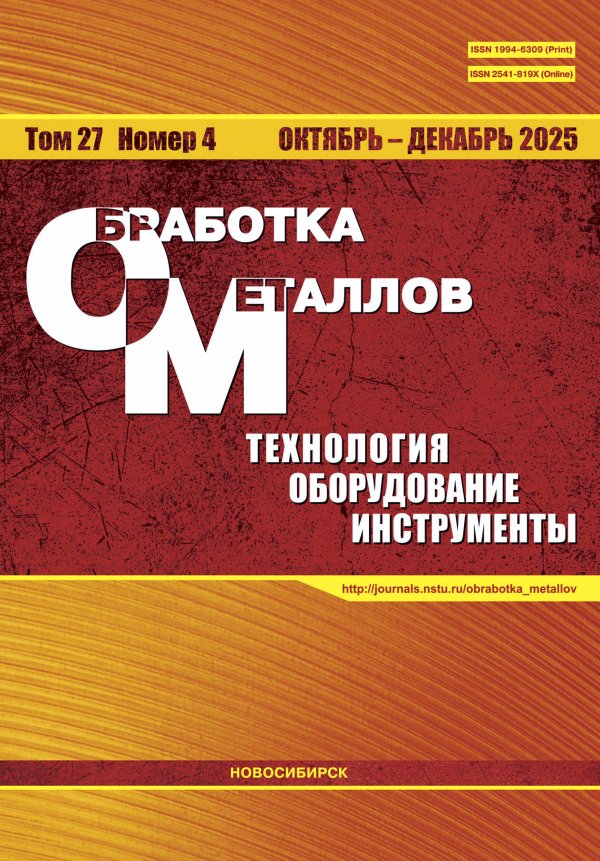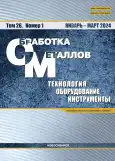Полуэмпирическое моделирование температуры резания и шероховатости поверхности при точении конструкционных материалов твердосплавным инструментом с покрытием TiAlN
- Авторы: Патил Н.1, Сараф А.1, Кулкарни А.1
-
Учреждения:
- Выпуск: Том 26, № 1 (2024)
- Страницы: 155-174
- Раздел: МАТЕРИАЛОВЕДЕНИЕ
- URL: https://journal-vniispk.ru/1994-6309/article/view/293122
- DOI: https://doi.org/10.17212/1994-6309-2024-26.1-155-174
- ID: 293122
Цитировать
Аннотация
Ключевые слова
Об авторах
Н. Патил
Email: nileshgpatil@rediffmaiil.com
ORCID iD: 0000-0002-4884-4267
Технологический институт Маратвада, Аурангабад-431010, штат Махараштра, Индия, nileshgpatil@rediffmaiil.com
А. Сараф
Email: atul.saraf001@gmail.com
ORCID iD: 0000-0003-4776-6874
Национальный технологический институт Сардара Валлабхбая, Сурат, Гуджарат 395007, Индия, atul.saraf001@gmail.com
А. Кулкарни
Email: atul.kulkarni@viit.ac.in
ORCID iD: 0000-0002-6452-6349
Институт информационных технологий Вишвакармы, Кондва (Бадрек), Пуне - 411048, штат Махараштра, Индия, atul.kulkarni@viit.ac.in
Список литературы
- Empirical modelling and optimization of temperature and machine vibration in CNC hard turning / P.S. Ghosh, S. Chakraborty, A.R. Biswas, N.K. Mandal // Materials Today: Proceedings. – 2018. – Vol. 5 (5). – P. 12394–12402. – doi: 10.1016/j.matpr.2018.02.218.
- Groover M.P. Fundamentals of modern manufacturing: materials, processes, and systems. – 4th ed. – Hoboken, NJ: Wiley, 2010. – 1012 p. – ISBN 978-0470-467002.
- Cutting temperature measurement using an improved two-color infrared thermometer in turning Inconel 718 with whisker-reinforced ceramic tools / J. Zhao, Z. Liu, B. Wang, Y. Hua, Q. Wang // Ceramics International. – 2018. – Vol. 44 (15). – P. 19002–19007. – doi: 10.1016/j.ceramint.2018.07.142.
- Kakade H.B., Patil N.G. Comparative investigations into high speed machining of AB titanium alloy (Ti–6al–4v) under dry and compressed Co2 gas cooling environment // AIP Conference Proceedings. – 2018. – Vol. 2018 (1). – P. 20009-1–20009-9. – doi: 10.1063/1.5058246.
- Gunjal S.U., Sanap S.B., Patil N.G. Role of cutting fluids under minimum quantity lubrication: an experimental investigation of chip thickness // Materials Today: Proceedings. – 2020. – Vol. 28 (2). – P. 1101–1105. – doi: 10.1016/j.matpr.2020.01.090.
- Кулкарни А.П., Чинчаникар С., Саргаде В.Г. Теория размерностей и моделирование температуры на границе раздела стружка-инструмент при точении SS304 на основе искусственных нейронных сетей // Обработка металлов (технология, оборудование, инструменты). – 2021. – Т. 23, № 4. – С. 47–64. – doi: 10.17212/1994-6309-2021-23.4-47-64.
- Modelling of flank wear, surface roughness and cutting temperature in sustainable hard turning of AISI D2 steel / R. Kumar, A.K. Sahoo, R.K. Das, A. Panda, P.C. Mishra // Procedia Manufacturing. – 2018. – Vol. 20. – P. 406–413. – doi: 10.1016/j.promfg.2018.02.059.
- Gosai M., Bhavsar S.N. Experimental study on temperature measurement in turning operation of hardened steel (EN36) // Procedia Technology. – 2016. – Vol. 23. – P. 311–318. – doi: 10.1016/j.protcy.2016.03.032.
- Abhang L.B., Hameedullah M. Chip-tool interface temperature prediction model for turning process // International Journal of Engineering Science and Technology. – 2010. – Vol. 2 (4). – P. 382–393.
- Doniavi A., Eskanderzade M., Tahmsebian M. Empirical modeling of surface roughness in turning process of 1060 steel using factorial design methodology // Journal of Applied Sciences. – 2007. – Vol. 7 (17). – P. 2509–2513. – doi: 10.3923/jas.2007.2509.2513.
- Verma V., Kumar J., Singh A. Optimization of material removal rate and surface roughness in turning of 316 steel by using full factorial method // Materials Today: Proceedings. – 2020. – Vol. 25. – P. 793–798. – doi: 10.1016/j.matpr.2019.09.029.
- Investigation on surface roughness and chip reduction coefficient during turning aluminium matrix composite / D. Das, R.F. Ali, B.B. Nayak, B.C. Routara // Materials Today: Proceedings. – 2019. – Vol. 5 (11). – P. 23541–23548. – doi: 10.1016/j.matpr.2018.10.142.
- Bhople N., Patil N., Mastud S. The experimental investigations into dry turning of austempered ductile iron // Procedia Manufacturing. – 2018. – Vol. 20. – P. 227–232. – doi: 10.1016/j.promfg.2018.02.033.
- Analysis of surface roughness and cutting force components in hard turning with CBN tool: prediction model and cutting conditions optimization / H. Aouici, M.A. Yallese, K. Chaoui, T. Mabrouki, J.F. Rigal // Measurement. – 2012. – Vol. 45 (3). – P. 344–353. – doi: 10.1016/j.measurement.2011.11.011.
- Longbottom J.M., Lanham J.D. Cutting temperature measurement while machining – a review // Aircraft Engineering and Aerospace Technology. – 2005. – Vol. 77 (2). – P. 122–130. – doi: 10.1108/00022660510585956.
- Korkut I., Ac?r A., Boy M. Application of regression and artificial neural network analysis in modelling of tool–chip interface temperature in machining // Expert Systems with Applications. – 2011. – Vol. 38 (9). – P. 11651–11656. – doi: 10.1016/j.eswa.2011.03.044.
- Dhar N.R., Kamruzzaman M. Cutting temperature, tool wear, surface roughness and dimensional deviation in turning AISI-4037 steel under cryogenic condition // International Journal of Machine Tools and Manufacture. – 2007. – Vol. 47 (5). – P. 754–759. – doi: 10.1016/j.ijmachtools.2006.09.018.
- Patil N.G., Brahmankar P.K. Semi-empirical modeling of surface roughness in wire electro-discharge machining of ceramic particulate reinforced Al matrix composites // Procedia CIRP. – 2016. – Vol. 42. – P. 280–285. – doi: 10.1016/j.procir.2016.02.286.
- Patel D.R., Kiran M.B. A non-contact approach for surface roughness prediction in CNC turning using a linear regression model // Materials Today: Proceedings. – 2020. – Vol. 26. – P. 350–355. – doi: 10.1016/j.matpr.2019.12.029.
- Patel V.D., Gandhi A.H. Analysis and modeling of surface roughness based on cutting parameters and tool nose radius in turning of AISI D2 steel using CBN tool // Measurement. – 2019. – Vol. 138. – P. 34–38. – doi: 10.1016/j.measurement.2019.01.077.
- Rodríguez J., Munoz-Escalona P., Cassier Z. Influence of cutting parameters and material properties on cutting temperature when turning stainless steel // Revista de la Facultad de Ingeniería Universidad Central de Venezuela. – 2011. – Vol. 26 (1). – P. 71–80.
- Rajput R.K. A textbook of fluid mechanics and hydraulic machines. – New Delhi: S. Chand, 2004. – ISBN 9789385401374.
- Optimization of CNC turning parameters on aluminum alloy 6063 using Taguchi Robust Design / A. Saravanakumar, S.C. Karthikeyan, B. Dhamotharan, V. Gokul kumar // Materials Today: Proceedings. – 2018. – Vol. 5 (2). – P. 8290–8298. – doi: 10.1016/j.matpr.2017.11.520.
- Smith W.F. Structure and properties of engineering alloys. – New York: McGraw-Hill, 1981. – 512 p. – ISBN 0070585601. – ISBN 978-0070585607.
- Zou B., Chen M., Li S. Study on finish-turning of NiCr20TiAl nickel-based alloy using Al2O3/TiN-coated carbide tools // The International Journal of Advanced Manufacturing Technology. – 2011. – Vol. 53 (1). – P. 81–92. – doi: 10.1007/s00170-010-2823-z.
- Dessoly V., Melkote S.N., Lescalier C. Modeling and verification of cutting tool temperatures in rotary tool turning of hardened steel // International Journal of Machine Tools and Manufacture. – 2004. – Vol. 44 (14). – P. 1463–1470. – doi: 10.1016/j.ijmachtools.2004.05.007.
- Rezende B.A., Magalhaes F.C., Rubio J.C.C. Study of the measurement and mathematical modelling of temperature in turning by means equivalent thermal conductivity // Measurement. – 2020. – Vol. 152. – P. 107275. – doi: 10.1016/j.measurement.2019.107275.
- Kitagawa T., Kubo A., Maekawa K. Temperature and wear of cutting tools in high-speed machining of Inconel 718 and Ti–6Al–6V–2Sn // Wear. – 1997. – Vol. 202 (2). – P. 142–148. – doi: 10.1016/S0043-1648(96)07255-9.
- Pawade R.S., Joshi S.S. Analysis of acoustic emission signals and surface integrity in the high-speed turning of Inconel 718 // Proceedings of the Institution of Mechanical Engineers, Part B: Journal of Engineering Manufacture. – 2012. – Vol. 226 (1). – P. 3–27. – doi: 10.1177/0954405411407656.
- Prediction of surface roughness and cutting zone temperature in dry turning processes of AISI304 stainless steel using ANFIS with PSO learning / M. Ayd?n, C. Karakuzu, M. Uçar, A. Cengiz, M.A. Çavuslu // The International Journal of Advanced Manufacturing Technology. – 2013. – Vol. 67 (1). – P. 957–967. – doi: 10.1007/s00170-012-4540-2.
Дополнительные файлы







